人教版九年级英语下专题复习1名词【教案】
- 格式:doc
- 大小:169.50 KB
- 文档页数:6

人教版初中英语总复习教案全
本文档旨在为初中英语教师提供一份全面的教学复教案。
具有以下特点:
- 适用范围广:适用于人教版初中英语各个年级,各个阶段的研究阶段;
- 内容全面:全面评估各个知识点,包括听、说、读、写和语法;
- 使用方便:书写清晰简单,易于理解;
- 时效性强:最新修订,反映最学进展。
本教案的具体内容包括以下几个方面:
一、听力
听力方面主要是针对教学中常出现的听力考试所需的听力题型进行分类讲解,同时也提供了丰富的听力练。
二、口语
口语方面包括了常见的口语活动和口语练题,针对学生在口语表达中容易出现错误或口语不精的问题进行详细的解答。
三、阅读
针对人教版初中英语阅读试题的题型,本教案详细解析了各种阅读理解题型的题目结构及解题技巧,同时为教师们提供了丰富的阅读材料。
四、写作
写作方面主要涉及英语写作的基本要求以及各种写作题型的写作格式及解题方法,同时也提供了大量的英文范文供学生参考。
五、语法
语法方面重点讲解了初中英语语法的基础知识点和易错点,同时也提供了相关的练题供学生练。
希望这份教案能够对初中英语的教学有所帮助,同时也希望教师们能够根据实际情况和教学需要进行适当的调整和补充。

人教版中考英语一轮复习第十四讲九年级Units 1-2教案一. 教材分析人教版中考英语一轮复习第十四讲主要涉及九年级Units 1-2的内容。
这部分教材主要讲述了日常生活中的交际用语和一些基本的语法知识。
通过这部分的学习,学生可以提高自己的英语交际能力,并为接下来的学习打下坚实的基础。
二. 学情分析九年级的学生已经具备了一定的英语基础,对于日常的交际用语和基本语法知识有一定的了解。
但是,部分学生在口语表达和听力方面还存在一定的困难,需要通过大量的练习来提高。
此外,学生对于英语学习的兴趣和动机也需要进一步激发和培养。
三. 教学目标1.知识目标:学生能够掌握九年级Units 1-2中的日常交际用语和基本语法知识。
2.能力目标:学生能够流利地运用所学的交际用语进行日常交流,提高自己的英语听说能力。
3.情感目标:激发学生对英语学习的兴趣和动机,培养良好的学习习惯。
四. 教学重难点1.重点:九年级Units 1-2中的日常交际用语和基本语法知识。
2.难点:对于一些特殊语境下的交际用语和复杂语法的理解和运用。
五. 教学方法采用任务型教学法,通过大量的听说练习和小组合作活动,激发学生的学习兴趣,提高学生的英语交际能力。
同时,结合语法讲解和练习,巩固学生的语法知识。
六. 教学准备1.教材:人教版九年级英语教材。
2.多媒体设备:电脑、投影仪、音响等。
3.教学资源:相关音频、视频、图片等。
七. 教学过程1.导入(5分钟)通过播放一段英语歌曲或视频,引导学生进入英语学习的状态。
然后,教师用简单的英语问候学生,询问他们的日常情况,激发学生的英语交际欲望。
2.呈现(10分钟)教师通过展示九年级Units 1-2的教材内容,引导学生复习已学的日常交际用语和基本语法知识。
在呈现过程中,教师可以用图片、实物等辅助教学,帮助学生更好地理解和记忆。
3.操练(15分钟)教师学生进行小组合作活动,模拟真实的日常交际场景,让学生运用所学的交际用语进行交流。

人教版英语九年级Unit-1-教案Unit 1 How can we become good learners?学习目标认知目标:1. Talk about how to study. 学会讨论各种学习方法和策略。
2. Find out your suitable learning methods. 找出适合自己的学习方法。
情感目标:通过对学习方法的学习,培养学生用正确而科学的方法做事的能力,明白“一份耕耘,一份收获”。
技能目标:(1)熟练掌握下列词汇:aloud pronunciation discover repeat note pronounce increase speed partner create active connect review knowledge wisely born attention(2)熟练掌握下列短语:work with friends ask the teacher for help read aloud look up practice pronunciationconnect…with…pay attention to(3)掌握下列句型:How do you study English?I learn by working with a group.Do you learn English by reading aloud?Yes, I do. It helps my pronunciation.How can I read faster?You can read faster by reading word groups.How can I improve my pronunciation?One way is by listening to tapes.But whether or not you can do this well depends on your learning habits.重点、难点(Key points and difficulties)1. 学会运用how来询问做事方式2. 学会运用by + doing的结构表达做事方式。

人教版中考英语专题复习《冠词专题》教案一. 教材分析《人教版中考英语》教材在冠词专题部分,主要围绕不定冠词a/an和定冠词the的用法进行讲解。
这部分内容是中考英语考试的重点,也是学生容易出错的点。
教材通过典型例句和练习,帮助学生理解和掌握冠词的用法。
二. 学情分析学生在学习冠词专题时,通常已经掌握了部分冠词的用法,但对其具体用法和适用场合理解不深,容易混淆。
此外,学生在使用冠词时,常常出现漏用、错用的情况。
因此,教师需要通过详细的讲解和大量的练习,帮助学生巩固冠词知识。
三. 教学目标1.知识目标:使学生掌握不定冠词a/an和定冠词the的用法,能正确运用冠词修饰名词。
2.能力目标:培养学生运用冠词进行交际的能力。
3.情感目标:激发学生学习英语的兴趣,培养其积极向上的学习态度。
四. 教学重难点1.重点:不定冠词a/an和定冠词the的用法。
2.难点:冠词的适用场合和具体用法。
五. 教学方法采用任务型教学法,通过大量的练习和实际交际场景,让学生在实践中学习和掌握冠词的用法。
同时,运用提问法、讨论法等,激发学生的思维,提高其学习兴趣。
六. 教学准备1.准备相关PPT课件,展示冠词的用法和典型例句。
2.准备练习题,用于巩固所学知识。
3.准备一些日常用品,如苹果、书籍等,用于实际操作演示。
七. 教学过程1.导入(5分钟)利用提问法,引导学生回顾已学的冠词知识,如不定冠词a/an和定冠词the的用法。
同时,通过展示一些日常用品,如苹果、书籍等,激发学生的学习兴趣。
2.呈现(10分钟)利用PPT课件,展示不定冠词a/an和定冠词the的用法,以及它们的具体适用场合。
通过典型例句,让学生理解并掌握冠词的用法。
3.操练(10分钟)将学生分成小组,每组选一个日常用品,如苹果、书籍等。
要求学生用不定冠词a/an和定冠词the造句,描述这个日常用品。
完成后,各组之间进行交流和讨论,互相纠正错误。
4.巩固(10分钟)出示练习题,要求学生独立完成。

人教版九年级下册英语全册教案一、教学目标1.让学生掌握本册书的核心词汇、短语和句型,提高学生的英语综合运用能力。
2.培养学生的听说读写技能,提高学生的英语实际运用能力。
二、教学内容1.Unit1-3:重点学习动词时态、被动语态、宾语从句等语法知识。
2.Unit4-6:重点学习情态动词、条件句、祈使句等语法知识。
3.Unit7-9:重点学习名词性从句、定语从句、状语从句等语法知识。
4.Unit10-12:重点学习过去进行时、过去完成时、过去将来时等语法知识。
Unit11.教学目标:学习一般过去时的动词变化,掌握过去进行时和过去完成时的区别。
2.教学重点:一般过去时的动词变化,过去进行时和过去完成时的运用。
3.教学难点:过去进行时和过去完成时的区别。
4.教学步骤:Step1:导入通过图片或故事引入本课主题,激发学生的学习兴趣。
Step2:讲解语法讲解一般过去时的动词变化,过去进行时和过去完成时的用法。
Step3:课堂练习学生进行课堂练习,巩固所学知识。
Step4:小组讨论学生分组讨论,运用所学知识进行实际交流。
Unit21.教学目标:学习情态动词can、may、must等,掌握其用法和区别。
2.教学重点:情态动词can、may、must的用法。
3.教学难点:情态动词的区别和实际运用。
4.教学步骤:Step1:导入通过图片或情景引入本课主题,激发学生的学习兴趣。
Step2:讲解语法讲解情态动词can、may、must的用法和区别。
Step3:课堂练习学生进行课堂练习,巩固所学知识。
Step4:角色扮演学生进行角色扮演,运用所学知识进行实际交流。
Unit31.教学目标:学习宾语从句的构成和用法,提高学生的句子表达能力。
2.教学重点:宾语从句的构成和用法。
3.教学难点:宾语从句的实际运用。
4.教学步骤:Step1:导入通过图片或故事引入本课主题,激发学生的学习兴趣。
Step2:讲解语法讲解宾语从句的构成和用法。

Unit 1How can we become good learners?类别课程标准要求掌握的项目单元话题Talk about how to study, in this unit, students learn to talk about how to study for a test and give advice to those who havedifficulties in studying.单元语法By + sth./doing sth.教学目标1.语言目标:理解重点句子,掌握学习英语的方法。
介词by引导的方式状语的合理运用。
2.技能目标:正确运用动名词谈论学习中的问题。
3.情感目标:通过开展角色表演等活动,培养学生阅读兴趣。
通过本单元的阅读,培养学生的文化意识,陶冶思想情操,让学生树立终身学习的道德素养。
学情分析英语的学习方法很多。
其实不是所有的学习方法都适合自己。
因此,我们要学会评价与判断,然后才能选择最适合自己的方法。
用下面的语言进行评价:I think studying Englishby…is…because…教学设计知识目标类别课时要点重点单词1.textbook n. 教科书;课本2.conversation n. 交谈;谈话3.aloud adv. 大声地;出声地4.pronunciation n. 发音;读音5.sentence n. 句子6.patientadj. 有耐心的n. 病人重点词组 1.make word cards 制作生词卡2.read the textbook 阅读教材3.ask the teacher for help 向老师求助课堂环节§自主学习案翻译下列词组。
1.通过制作生词卡by__making__word__cards2.通过听录音带by__listening__to__tapes3.向某人寻求帮助ask__sb.for__help4大声读来练习发音read__aloud__to__practice__pronunciation 5.小组合作学习study__with__a__group6.和朋友练习对话practice__conversations__with__friends7.逐个单词word__by__word8.作报告give__a__report9.意群word__groups10.慢慢来it__takes__time11.口语技能speaking__skills12英语口语spoken__English§课堂导学案Step 1 准备与热身(Preparation)Leadin with a free talk(自由对话导入新课)(2分钟)Greeting with the students:Hello, everyone.Welcome back to school.I'm very happy to see you again.Most of you got good grades last term ! Of course, don't lose your heart if you didn't get good grades.OK.Today, let's talk about how to study for a test and how to learn English well.T: How do you study English? Do you study English by the following ways? (Show some pictures and present the important phrases.) T: How do you study English?S: I study English by ________.working with friends making word cardsasking the teacher for help reading the textbookworking with a group listening to tapesStep 2 呈现与输入(Presentation)1.要求学生翻开课本P1,迅速阅读1a部分的内容。
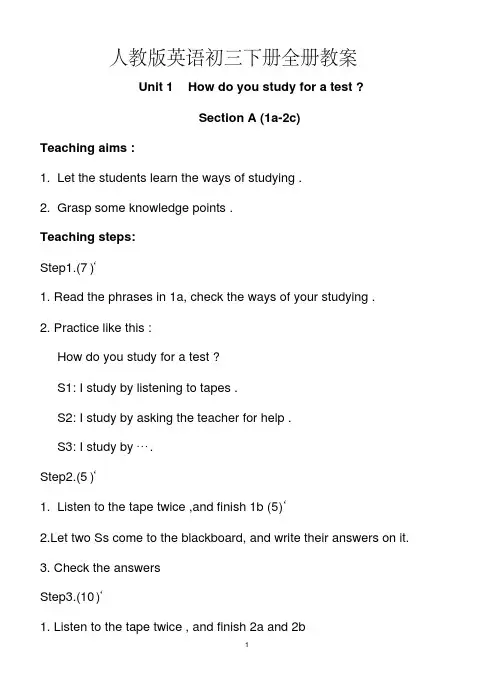
人教版英语初三下册全册教案Unit 1 How do you study for a test ?Section A (1a-2c)Teaching aims :1.Let the students learn the ways of studying .2.Grasp some knowledge points .Teaching steps:Step1.(7‘)1. Read the phrases in 1a, check the ways of your studying .2. Practice like this :How do you study for a test ?S1: I study by listening to tapes .S2: I study by asking the teacher for help .S3: I study by ….Step2.(5‘)1.Listen to the tape twice ,and finish 1b (5‘)2.Let two Ss come to the blackboard, and write their answers on it.3. Check the answersStep3.(10‘)1. Listen to the tape twice , and finish 2a and 2b2.Let two Ss come to the blackboard, and write their answers on it.3. Check the answersStep4.(13‘)1. Practice in class .Make dialogs in pairs according to 2a and 2b .2.Act them out .Class exercises(10’)一.用括号内所给单词的正确形式填空。
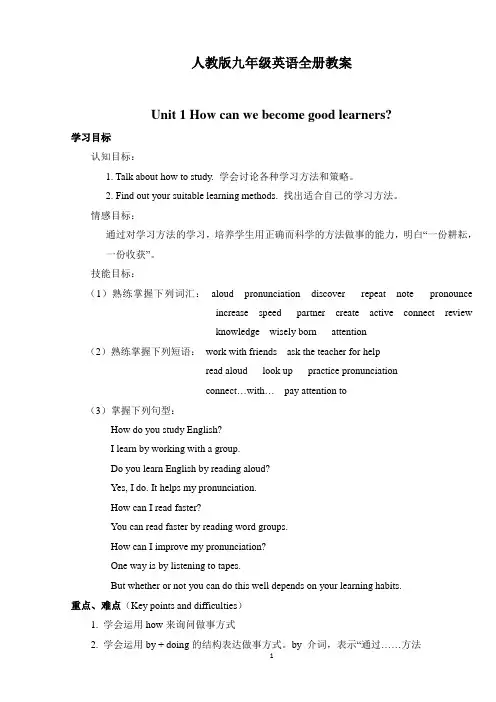
人教版九年级英语全册教案Unit 1 How can we become good learners?学习目标认知目标:1. Talk about how to study. 学会讨论各种学习方法和策略。
2. Find out your suitable learning methods. 找出适合自己的学习方法。
情感目标:通过对学习方法的学习,培养学生用正确而科学的方法做事的能力,明白“一份耕耘,一份收获”。
技能目标:(1)熟练掌握下列词汇:aloud pronunciation discover repeat note pronounceincrease speed partner create active connect reviewknowledge wisely born attention(2)熟练掌握下列短语:work with friends ask the teacher for helpread aloud look up practice pronunciationconnect…with…pay attention to(3)掌握下列句型:How do you study English?I learn by working with a group.Do you learn English by reading aloud?Yes, I do. It helps my pronunciation.How can I read faster?You can read faster by reading word groups.How can I improve my pronunciation?One way is by listening to tapes.But whether or not you can do this well depends on your learning habits.重点、难点(Key points and difficulties)1. 学会运用how来询问做事方式2. 学会运用by + doing的结构表达做事方式。
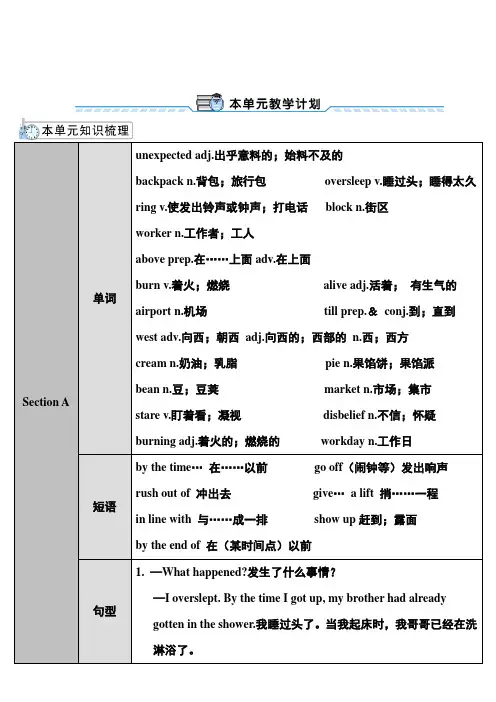
Section A 单词unexpected adj.出乎意料的;始料不及的backpack n.背包;旅行包oversleep v.睡过头;睡得太久ring v.使发出铃声或钟声;打电话block n.街区worker n.工作者;工人above prep.在……上面adv.在上面burn v.着火;燃烧alive adj.活着;有生气的airport n.机场till prep.&conj.到;直到west adv.向西;朝西adj.向西的;西部的n.西;西方cream n.奶油;乳脂pie n.果馅饼;果馅派bean n.豆;豆荚market n.市场;集市stare v.盯着看;凝视disbelief n.不信;怀疑burning adj.着火的;燃烧的workday n.工作日短语by the time…在……以前go off(闹钟等)发出响声rush out of 冲出去give…a lift 捎……一程in line with 与……成一排show up赶到;露面by the end of 在(某时间点)以前句型1. —What happened?发生了什么事情?—I overslept. By the time I got up, my brother had alreadygotten in the shower.我睡过头了。
当我起床时,我哥哥已经在洗淋浴了。
句型1.Many people ran to their local supermarkets to buy as much spaghetti as they could.许多人跑去当地的超市尽可能多地买意大利面条。
2. The lady was so happy because she really wanted to get married.这位女士很高兴,因为她真的很想结婚。
3.One of the world\'s most famous tricks, however, happened in October rather than in April.然而,世界上最著名的愚弄人的玩笑有一个是发生在十月,而不是在四月。
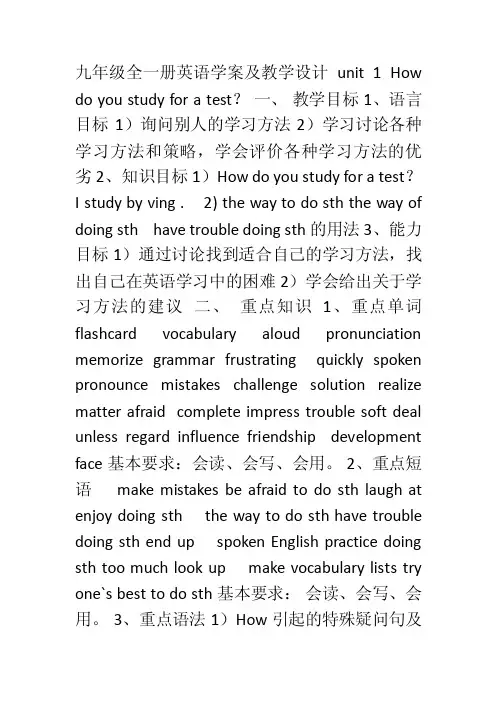
九年级全一册英语学案及教学设计unit 1 How do you study for a test?一、教学目标 1、语言目标1)询问别人的学习方法 2)学习讨论各种学习方法和策略,学会评价各种学习方法的优劣 2、知识目标 1)How do you study for a test?I study by ving . 2) the way to do sth the way of doing sth have trouble doing sth 的用法 3、能力目标 1)通过讨论找到适合自己的学习方法,找出自己在英语学习中的困难 2)学会给出关于学习方法的建议二、重点知识1、重点单词flashcard vocabulary aloud pronunciation memorize grammar frustrating quickly spoken pronounce mistakes challenge solution realize matter afraid complete impress trouble soft deal unless regard influence friendship development face 基本要求:会读、会写、会用。
2、重点短语make mistakes be afraid to do sth laugh at enjoy doing sth the way to do sth have trouble doing sth end up spoken English practice doing sth too much look up make vocabulary lists try one`s best to do sth 基本要求:会读、会写、会用。
3、重点语法 1)How 引起的特殊疑问句及其回答 2)the way to do sth the way of doing sthhave trouble doing sth 的用法基本要求:理解其含义,学以致用。
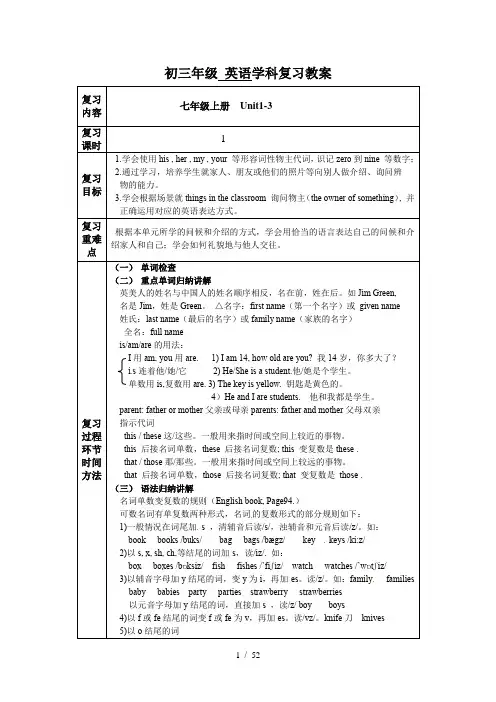
初三年级英语学科复习教案(一)单词检查(二)重点单词归纳讲解英美人的姓名与中国人的姓名顺序相反,名在前,姓在后。
如Jim Green, 名是Jim,姓是Green。
△名字:first name(第一个名字)或given name 姓氏:last name(最后的名字)或family name(家族的名字)全名:full nameis/am/are的用法:I用am, you用are. 1) I am 14, how old are you? 我14岁,你多大了?i s连着他/她/它2) He/She is a student.他/她是个学生。
单数用is,复数用are. 3) The key is yellow. 钥匙是黄色的。
4)He and I are students. 他和我都是学生。
parent: father or mother父亲或母亲parents: father and mother父母双亲指示代词this / these这/这些。
一般用来指时间或空间上较近的事物。
this 后接名词单数,these 后接名词复数; this 变复数是these .that / those那/那些。
一般用来指时间或空间上较远的事物。
that 后接名词单数,those 后接名词复数; that 变复数是those .(三)语法归纳讲解名词单数变复数的规则(English book, Page94.)可数名词有单复数两种形式,名词的复数形式的部分规则如下:1)一般情况在词尾加-s ,清辅音后读/s/,浊辅音和元音后读/z/。
如:book----books /buks/ bag----bags /bægz/ key----keys /ki:z/2)以s, x, sh, ch,等结尾的词加-s,读/iz/. 如:box----boxes /bɒksiz/ fish----fishes /’fiʃiz/ watch----watches /’wɒtʃiz/3)以辅音字母加y结尾的词,变y为i,再加-es。
中考英语总复习教案一语法重点:一般现在时态 (Simple Present tense)难点突破:一般现在时态中第三人称时动词加“s”的用法知识目标:通过操练、点评、专项练习等方式复习“一般现在时态”的时态结构。
复习步骤设计:(一)词汇复习Revision of the words and phrases learnt in UnitOne,dictationof the main ones。
(此环节也可根据中考词汇表顺序进行听写检查)(二)对话操练Dialogue Acting—ask Ss to act out some dialogues aboutWhat do you usually do on Sundays/in the evening? (此环节也可以采取学生达标积分制进行,即复习阶段课前对话必须人人参与)(三)语法复习:一般现在时态:(A) 概念:表示某人/某事物经常发生的动作、习惯、状态等。
(B) 时态信号:常与sometimes, often, usually, always, every day, in the morning, on Sunday 等词连用。
(C) 动词形式:用实义动词原形,第三人称时用动词加“s”形式,简称“三单动s”形式,“Be”动词用“am/ is/ are ”的形式。
(D)情态动词后面直接加实义动词原形。
(E) 在某些动词后面须用动词原形进行搭配,如let sb do sth, You’d beterr do sth 等。
例解:1、Now let me ____ your names, OK?A. callB. to callC.calling D. calls此题应选用“A”项。
在“Let sb.”后面的结构中应该用动词原形结构,不可以用其它形式,所以B项、C项和D项都是错误的。
2、He ________ the washing on Sundays. He _____ it on Saturdays.A. doesn’t/ doesB. don’t do/does C. doesn’t do/ does D. not does/ does此题应选用“C”项。
2018年人教版中考英语九年级英语总复习教案课时授课计划授课日期___年___月___日星期___课时授课计划授课日期___年___月___日星期___课时授课计划授课日期___年___月___日星期___课时授课计划授课日期___年___月___日星期___课时授课计划授课日期___年___月___日星期___课时授课计划授课日期___年___月___日星期___课时授课计划授课日期___年___月___日星期___央电视台的世界各地节目。
易混淆词组:1)Thanks for doing sth. 因为某事而感谢你造句:2)Thanks to … = Because of …多亏了…由于…造句:3. How’s the weather in Beijing ? It’s rainy .北京的天气怎么样?有雨划线部分= _________ the weather ________ ?请写出下列各词的形容词形式:sun-______ , cloud-______, snow-______ ,rain-______ 同义词_______, fog- ______, wind-______.It’s rainy. 同义句:There ________________ . 或It ___________________ .4.I’m pretty good ! 我很好!划线部分提问______ it ________? :你怎么样?(两人见面时)同义句:How____________________________ ?5. Some are taking photos, others are lying on the beach .一些人正在拍照, 另一些正躺在沙滩上。
Some … others …一些…, 另一些…造句:易混淆词组:1)one…the other … (两者中)一个…另一个…造句:2)another (三个或更多中的)另一个造句:6. I am surprised they can play in this heat . 是我吃惊的是他们能在这么热的天打排球。
九年级英语下专题复习1名词教案 【教学目标】 1. 梳理可数名词与不可数名词的用法。2. 理清运用名词所有格的用法。 3. 例解名词词义辨析。
【教学重点难点】 名词的用法及辨析 【知识梳理】 名词是用来表示人、事物、地点、现象及其他抽象概念等名称的词。名词在英语词汇中占有较大的比例,历年中考试题都要涉及,分值在2-3分,考点常分布在单项选择、完形填空和完成句子中。近几年的中考在淡化语法的同时,突出了语言的交际性和实用性,中考热点主要集中在:1. 正确识别可数名词和不可数名词;2. 掌握可数名词复数形式的构成; 3. 正确判断某些常用名词在特定语境中的可数和不可数性;4. 掌握名词所有格的基本形式及一般用法。攻克方法:要求学生全面掌握初中阶段所学的英语知识,系统地做好语法归纳并有意识地多记一些名词惯用语,尤其是与汉语不同的一些特殊用法。 考点一:可数名词与不可数名词 [考点透析] 在可数名词与不可数名词的考查上一般出现这样几类:(1)可数名词复数的不规则变化;(2)不可数名词的量化表达;(3)可数名词和不可数名词的修饰词。所以,大家首先要能够明确哪些是可数名词,哪些是不可数名词。其次,还要知道可数名词的复数的变化规则以及可数名词和不可数名词的修饰词。另外,还要掌握不可数名词的量化表达有:a bottle of,a cup of,a glass of,a bag of等。 [品味中考] 1. I like a lot, and my mother usually cooks it in different ways. A. fish B. potatoes C. noodles (山西卷) [考题解答] 1. A。句中it指代不可数名词fish,但是不能指代可数名词复数potatoes或noodles。 [知识链接] 可数名词的复数变化规则: 1.一般是在单数可数名词词尾加—s。例如:boy→ boys,egg→ eggs 2.以s,x,ch,sh结尾的,在词尾加-es。例如:bus→ buses,watch→ watches 3.以辅音字母加y结尾的,变y为i,再加—es。例如: story→ stories,family→ families 4.以f或fe结尾的,变f或fe为v,再加—es。例如: leaf→ leaves,knife→ knives 5.以o结尾的,一般在词尾加-s (加-es的有hero,potato,tomato等)。 例如:photo→ photos,zoo→ zoos 不规则变化:1.元音字母变化。例如:foot→ feet,woman→ women 2.词尾变化。例如:child—children,mouse→ mice 3.单复数同形。例如:Chinese,sheep [温馨提示]1.名词作定语一般用单数形式,如:an apple tree (一棵苹果树),three car factories (三个汽车厂)。但是修饰名词复数时例外,如:two men teachers (两位男教师)。 2.不可数名词没有复数形式。不可数名词作主语,谓语应用单数形式。 3.单数集合名词作主语时谓语动词“数”的变化:单数集合名词(如class,police,family,school,group,team等)尽管形式上是单数,意义上都是复数,因此,一般要与复数谓语动词连用,例如:His family are good to me.他的家人对我很好。(这里的family指家庭成员) 【注意】:当上述集合名词着重指“整体”时,意义上则是单数,因此,要与单数谓语动词连用。例如:Our school team often plays well in our city. 我们校队经常在我们市踢得很好。(这里的team指整个队,故谓语动词用plays) [针对练习] 1. You can get much about the World Expo on the Internet. A. map B. picture C. ticket D. information (上海卷) 2. The doctor told me to eat more because it’s good for my health. (江西卷) A. orange B. vegetables C. ice cream D. fish [考题解答] 1. D。information为不可数名词,可以用much修饰;而map,picture和ticket为可数名词,不能用much修饰。 2. D。句意:医生告诉我要多吃鱼,因为它有利于我的健康。本题考查名词词义的辨析及数的概念。orange橘子,橘汁,如取“橘汁”之意,与题干中的eat不符,如取“橘子”之意,应该用其复数形式,且与后面的it不符,故排除A项;根据题干中的it可知设空处为不可数名词,故排除B项;C项不符合语境,多吃冰激凌对身体不好,故排除C项;fish (鱼肉)为不可数名词,符合题意。 【名词单数变复数规则口诀】 名词单数变复数,一般加-s没有错。 词尾若是s, x, ch, sh,直接加上-es。 词尾若是f或fe,加-s之前要变ve。 “辅音字母+y”来结尾,变y为i有道理,再加-es没问题。 词尾字母若是o,加-es有tomato和potato。 不规则变化要特别记,oo变ee, foot----feet是一例。 男人女人a变e, woman----women看仔细。 child复数要记准,“孩子们”是children。 考点二:名词所有格 [考点透析]名词所有格用于表示有生命或无生命事物的所有关系或所属关系。[品味中考]1. -How far is it from here to the hospital? -It’s about ride. A. twenty minute B. twenty minutes C. twenty minutes’ D. twenty-minutes (淄博卷) [考题解答]1.C。ride在此为名词,根据“二十分钟的骑车路程”判断,选项中C正确。另外也可用twenty-minute来表示。 [知识链接]考查主要集中在以下几个方面:1. 表示有生命事物的名词所有格,一般在名词词尾加“’s”构成。这种所有格一般放在另一名词之前作定语。例如:the boy’s room 2.表示无生命事物的所有格,通常用“of+名词”结构。但应当注意词序与汉语习惯不同。例如:a map of China 3.有些表示时间、距离、国家、城市或团体等无生命事物的所有格,也可直接加“’s”构成。 例如:five minutes’ walk (五分钟的路程) [温馨提示] 1.以s结尾的名词或规则名词的复数,不能直接加“ ’s ”,而应该加“ ’ ”。例如:the boys’ teacher 2.表示并列名词共同的所有关系时,须在最后一个名词的词尾加“ ’s ”;若表示并列名词各自的所有关系,则须在各个名词后面加“ ’s ”。例如:Jim’s and Kate’s rooms (两人各自拥有),Jim and Kate’s father (两人共有) [针对练习] I don’t think looking after children is just________ work. A. woman B. woman’s C. women D. women’s (河北卷) [考题解答]1.D。women的所有格是women’s,在句中作work的定语。 【名词所有格用法口诀】 英语名词所有格,表示物品所有权。 名词后加 ’s,这种情况最常见。 两者共有添最后,各有各添记心间。 复数名词有s, 后面只把 ’来添。 名词若为无生命,我们常把of用。 A of B是B的A,体现英汉序不同。 考点三:名词词义辨析 [考点透析] 做考查名词词义辨析类的试题时,常常要根据题意、具体语境或地理常识来综合分析。 [品味中考] 1. -What kind of fruit is your favorite? -________. A. Rice B. Milk C. Apples D. Mutton (济宁卷) 2. -Could you tell me something about the boy who helped you just now? -Sorry, I know nothing about him. We are_________. A. friends B. neighbors C. classmates D. strangers (安徽卷) [考题解答]1. C。本题考查名词在具体语境中的运用。通过分析题干可以推断出正确答案是C项。apple属于水果。 2. D。friends意为“朋友”,neighbors意为“邻居”,classmates意为“同班同学”。这些关系都不能说I know nothing about him.只有是“陌生人”才可能不了解他的任何情况,故选D。 [知识链接与针对练习] 1.cloth, clothes, clothing与dress (1)cloth指“布”、“布料”。 (2)clothes指具体的衣服,包括内衣、外衣,不能与数词连用。 (3)clothing是服装的总称,包括内衣、外衣,还包括帽子、鞋袜、手套之类,只用单数,无复数。 (4)dress作不可数名词时,指外衣,尤指社交场合穿的服装。作可数名词时,常指连衣裙。 [针对练习]:①a dish ______ 答案:(cloth) ②I want to buy sports ___________. 答案:(clothes) ③Now people are all in their winter ____________. 答案:(clothing) ④She wore a blue __________ last night. 答案:(dress) 2.dinner与meal的区别 (1)dinner是指“正餐(午饭或晚饭)”或“宴会”。 (2)meal是指“一餐(一顿饭)”。 [针对练习]:①Let’s go and have _________ together. 答案:(dinner)